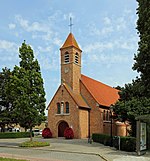SM U-5 (Germany)
1910 shipsGerman submarine stubsMaritime incidents in December 1914Ships built in KielType U 5 submarines ... and 5 more
U-boats commissioned in 1910U-boats sunk by minesU-boats sunk in 1914World War I shipwrecks in the North SeaWorld War I submarines of Germany

SM U-5 was a German Type U 5 U-boat built for the Imperial German Navy. She was commissioned 2 July 1910 in Germaniawerft in Kiel. She served in World War I under the command of Kptlt. Johannes Lemmer, with no recorded sinkings of enemy ships on two patrols. She was lost in an accident off the Belgian coast on 18 December 1914, and sank with no survivors - all of her 29 crew members died. On 4 September 2023, it was announced that the wreck of U-5 was successfully identified.
Excerpt from the Wikipedia article SM U-5 (Germany) (License: CC BY-SA 3.0, Authors, Images).SM U-5 (Germany)
Geographical coordinates (GPS) Address Nearby Places Show on map
Geographical coordinates (GPS)
| Latitude | Longitude |
|---|---|
| N 51.383333333333 ° | E 3.1833333333333 ° |
Address
België / Belgique / Belgien
Belgium
Open on Google Maps










